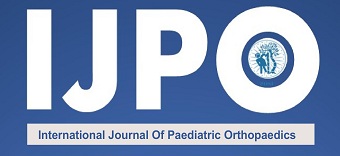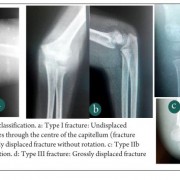The Hip in Skeletal Dysplasia: Evaluation & Management
Volume 11 | Issue 1 | Januar-April 2025 | Page: 29-38 | Gaurav Gupta, Easwar T R, Hitesh Shah, Mohan V Belthur
DOI- https://doi.org/10.13107/ijpo.2025.v11.i01.220
Open Access License: CC BY-NC 4.0
Copyright Statement: Copyright © 2024; The Author(s).
Submitted: 13/01/2025; Reviewed: 08/02/2025; Accepted: 15/03/2025; Published: 10/04/2025
Authors: Gaurav Gupta MS Ortho [1], Easwar T R MS Ortho [2], Hitesh Shah MS Ortho [3], Mohan V Belthur MS Ortho, FRCS (Tr & Orth), FRCSC [4, 5]
[1] Department of Orthopaedics, Child Ortho Clinic, Delhi-NCR, India.
[2] Department of Orthopaedics, Baby Memorial Hospital, Kozhikode, Kerala, India.
[3] Department of Orthopaedics, Kasturba Medical College, Manipal, Karnataka, India.
[4] Department of Orthopaedics, Phoenix Children’s Hospital, Phoenix, Arizona, USA.
[5] Department of Child Health & Orthopaedics, University of Arizona College of Medicine – Phoenix.
Address of Correspondence
Dr Mohan Belthur,
MD, FRCS (Tr & Orth), FRCSC
Department of Child Health & Orthopaedics, University of Arizona College of Medicine – Phoenix.
Director, Paediatric Limb Reconstruction Services
Co-Director, Neuroorthopaedic Services
Co-Director, Bubba Watson & Ping Motion Analysis Laboratory
Department of Orthopaedics, Phoenix Children’s Hospital, Phoenix, Arizona, USA.
Abstract
Skeletal dysplasias represent a heterogeneous group of over 500 genetic disorders affecting the growth, development, and structural integrity of bone and cartilage. Hip deformities in skeletal dysplasia (S.D) represent a significant challenge in pediatric orthopaedic practice. They significantly impact mobility and quality of life in children with S.D. Despite advances in surgical techniques and implant technology, patients with skeletal dysplasia continue to face higher complication rates and more challenging management decisions.
Early identification and intervention can prevent progressive deformity and secondary complications. A multidisciplinary approach combining careful preoperative planning, specialised surgical techniques, and dedicated rehabilitation protocols offers the best opportunity to optimise outcome.
Keywords: Skeletal Dysplasia, Hip deformities, Natural History, Management, Outcomes.
References
1. Handa A, Nishimura G, Zhan MX, Bennett DL, El-Khoury GY. A primer on skeletal dysplasias. Jpn J Radiol. 2022 Mar;40(3):245-261. doi: 10.1007/s11604-021-01206-5. Epub 2021 Oct 25. PMID: 34693503; PMCID: PMC8891206.
2. Osagie L, Figgie M, Bostrom M. Custom total hip arthroplasty in skeletal dysplasia. Int Orthop. 2012 Mar;36(3):527-31. doi: 10.1007/s00264-011-1314-7. Epub 2011 Jul 13. PMID: 21751022; PMCID: PMC3291760.
3. Wyles CC, Panos JA, Houdek MT, Trousdale RT, Berry DJ, Taunton MJ. Total Hip Arthroplasty Reduces Pain and Improves Function in Patients With Spondyloepiphyseal Dysplasia: A Long-Term Outcome Study of 50 Cases. J Arthroplasty. 2019 Mar;34(3):517-521. doi: 10.1016/j.arth.2018.10.028. Epub 2018 Oct 30. PMID: 30528131; PMCID: PMC6786491.
4. Pauli RM, Modaff P, Sipes SL, Whitelock I. (2019). Tailoring care for individuals with skeletal dysplasia: A practice guide. Am J Med Genet C Semin Med Genet, 181(4):545-559.
5. Trotter TL, Hall JG. (2020). Health supervision for children with achondroplasia. Pediatrics, 145(6).
6. Kadakia RJ, Haddad FS, Appleton P, et al. (2019). Hip disease in spondyloepiphyseal dysplasia: A long-term follow-up study. J Bone Joint Surg Br, 101-B(6):732-739.
7. Anthony S, Munk R, Skakun W, Masini M. (2015). Multiple epiphyseal dysplasia: A retrospective review of clinical and radiographic features at presentation. J Pediatr Orthop, 35(2):172-179.
8. Bonafe L, Cormier-Daire V, Hall C, et al. (2015). Nosology and classification of genetic skeletal disorders: 2015 revision. Am J Med Genet A, 167A(12):2869-2892.
9. Mathew CJ, Ho-Yan B, Clevidence BA, et al. (2014). Hip pathology in pseudoachondroplasia. J Pediatr Orthop, 34(5):519-523.
10. Mortier GR, Cohn DH, Cormier-Daire V, et al. (2019). Nosology and classification of genetic skeletal disorders: 2019 revision. Am J Med Genet A, 179(12):2393-2419.
11. Li D, Hu C, Wu Z, et al. (2017). The clinical and radiological outcomes of hip reconstruction in young patients with multiple epiphyseal dysplasia. J Orthop Surg Res, 12(1):123.
12. Wada A, Fujii T, Takamura K, et al. (2018). 3D assessment of hip deformities in skeletal dysplasia using CT imaging. J Pediatr Orthop, 38(9).
13. Zhang H, Yang R, Wang Y, et al. (2021). A comparative study of whole-exome sequencing and targeted panel sequencing in 312 patients with suspected skeletal dysplasia. Mol Genet Genomic Med, 9(1).
14. Moreno-De Luca A, Levin DE, Ortiz-Mantilla S, et al. (2018). Rehabilitation strategies in skeletal dysplasia: A systematic review. Arch Phys Med Rehabil, 99(6):1164-1176.
15. Gül D, Orsçelik A, Akpancar S. Treatment of Osteoarthritis Secondary to Developmental Dysplasia of the Hip with Prolotherapy Injection versus a Supervised Progressive Exercise Control. Med Sci Monit. 2020 Feb 11;26:e919166. doi: 10.12659/MSM.919166. PMID: 32045406; PMCID: PMC7034518.
16. Li Y, Zhou Y, Wang Z, et al. (2020). 3D printed patient-specific instrumentation techniques for complex hip deformity in skeletal dysplasia. J Orthop Surg, 15(1):93.
17. White KK, Bompadre V, Goldberg MJ, et al. (2017). Best practices in perioperative management of patients with skeletal dysplasias. Am J Med Genet A, 173(10):2584-2595.
18. Kanazawa K, Yonetani Y, Nakagawa Y, et al. (2019). Long-term outcome of hip reconstruction in skeletal dysplasia: A minimum 15-year follow-up study. J Pediatr Orthop, 39(9).
19. Laville J.M., Lakermance P., Limouzy F. Larsen’s syndrome: review of the literature and analysis of thirty-eight cases. J Pediatr Orthop. 1994;14:63–19. doi: 10.1097/01241398-199401000-00014. [DOI] [PubMed] [Google Scholar][Ref list]
20. Kishta W, Abduljabbar FH, Gdalevitch M, Rauch F, Hamdy R, Fassier F. Hip Dysplasia in Children With Osteogenesis Imperfecta: Association With Collagen Type I C-Propeptide Mutations. J Pediatr Orthop. 2017 Oct/Nov;37(7):479-483. doi: 10.1097/BPO.0000000000000644. PMID: 26371943; PMCID: PMC5592982.
21. Härkönen H, Loid P, Mäkitie O (2021) SLC26A2-associated diastrophic dysplasia and rMED—clinical features in affected finnish children and review of the literature. Genes 12:714. https://doi.org/10.3390/genes12050714
22. Shapiro F. Review of specific skeletal dysplasias. Pediatric ortho paedic deformities. Academic Press; 2001. p. 733–870.
23. Thacker MM, Ditro C, Mackenzie WS, Mackenzie WG, White KK. Limb lengthening and deformity correction in patients with skeletal dysplasias. InPediatric Lower Limb Deformities: Principles and Techniques of Management 2024 Aug 24 (pp. 537-559). Cham: Springer International Publishing.
24. Bayhan IA, Abousamra O, Rogers KJ, Bober MB, Miller F, Mackenzie WG. Valgus hip osteotomy in children with spondyloepiphyseal dysplasia congenita: midterm results. Journal of Pediatric Orthopaedics. 2019 Jul 1;39(6):282-8.
25. Treble NJ, Jensen FO, Bankier A, Rogers JG, Cole WG. Development of the hip in multiple epiphyseal dysplasia. Natural history and susceptibility to premature osteoarthritis. J Bone Joint Surg Br. 1990;72(6):1061–4.
26. Vaara P, Peltonen J, Poussa M, Merikanto J, Nurminen M, Kaitila I, et al. Development of the hip in diastrophic dysplasia. J Bone Joint Surg Br. 1998;80(2):315–20.
27. Bisht RU, Van Tassel DC, Belthur MV. Spondyloepiphyseal dysplasia congenita: Use of complementary 3D reconstruction imaging for preoperative planning. Clinical imaging. 2022 Jun 1;86:94-7.
| How to Cite this Article: Gupta G, TR Easwar, Shah H, Belthur MV | The Hip in Skeletal Dysplasia: Evaluation & Management | International Journal of Paediatric Orthopaedics | January-April 2025; 11(1): 29-38 |




